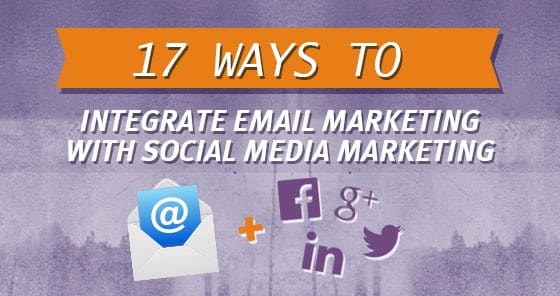On its own, email marketing is one of the most effective tools for driving conversions. Polls have shown again and again that customers prefer to receive sales messages via email, as opposed to any other medium, and studies have proven that email is a powerful method of driving sales.
Social media marketing, by itself, is one of the very best ways for your brand to connect with an online audience – by creating communities, nurturing relationships, and building a strong network of brand ambassadors who will provide online word-of-mouth advertising for your business.
Can you imagine the marketing power you’d be harnessing by integrating the two?
But integration doesn’t mean simply using both email and social media in your marketing strategy.
True integration means synching the two marketing channels as closely as possible, using each to link to the other, and creating a seamless experience for customers that provides all the benefits of both marketing channels – while boosting the power of each exponentially.
In order to create a truly integrated online marketing strategy that takes advantage of the combined forces of email marketing and social media marketing, you’ll need to stop thinking of each of these marketing methods as a separate entity. Instead, think of them as two sides of the same coin. Each side should always be connected in some way with the other. We’ve put together some tips to help get you started on strategizing.
1. First, the obvious – social media icons. Every single email you send should include social media icons. This is the easiest and most common way to link your email marketing activities with your social media marketing efforts – and the reason it’s so common is that it works. Every email subscriber on your list should be reminded of all your social media channels each time they get a message from you and should be provided with a convenient way to connect with you on each of them.
2. Just as obvious – social media share buttons. This is another no-brainer. In addition to encouraging your email recipients to connect with you on social media, you should also be prompting them to share your emails with their own personal social media networks.
3. Coordinate email subject lines and Facebook headlines. For the most part, your audiences on Facebook and your email list are people with similar interests and preferences. So what works well on one platform will work well on the other. If you’ve found success using a particular email subject line, try it out as a Facebook headline – and if you’ve gotten a lot of engagement from a particular Facebook headline, use it as an email subject line.
4. Incorporate video into your emails. Video is the latest addition to the email marketing world and one that can make a dramatic difference in conversions. Now that more email providers have enabled videos, actually sending out the videos you’ve posted to YouTube can work as a powerful tool for getting attention and encouraging clicks. For recipients who can’t view the video in their email, be sure to include a link to the video, as well.
5. Include social media fan interactions in your emails. Think of your emails as a channel for broadcasting what happens on social media – and of your social media posts as channels for broadcasting what your emails are about. Send out emails that highlight the best comments, fan images, and conversations happening on your social media networks – not only will it make for interesting content, but it will also make people want to get in on the fun themselves.
6. Feature a social media fan of the month in your emails. Focusing in on one particular fan can be another great way to drive engagement. That fan will share the email with his network, and others will be motivated to interact with your brand via social media in order to be chosen themselves.
7. Announce upcoming emails on social media. In keeping with tip #5, use social media as a place to spread the word about the content in your emails. To make people want to subscribe, give them tantalizing sneak peeks at what they’re missing out on.
8. Share links to web-based versions of your emails on social media. Once an email has gone out, leverage it even further by letting your social media fans see its content, too. If they like what they see, they’ll probably subscribe, so they won’t risk missing one in the future.
9. Customize emails for each user’s preferred social media platform. Segment your email list according to the recipients’ favorite social media platform, and then send out email digests of the all the activity that’s been happening on that channel. You could have a Facebook Review, a Twitter Digest, or even a Pinterest Scrapbook.
10. Send an email dedicated solely to asking recipients to connect with your brand on a certain social media platform. Maybe it’s an email telling them about the benefits of following you on Twitter or one about how much fun they could have if they joined you on Pinterest. If you are trying to grow your community on any or all social media platforms, invite your subscribers first!
11. Use your interactions with fans on Facebook to determine email content. You can simply observe what the most popular topics are on your Facebook page, or you can come right out and ask fans what they’d like to see in your emails. Not only will your emails be tailored more specifically to their interests, but they’ll want to sign up to receive the content that they had a hand in asking for.
12. Ask for the conversion. In your emails, ask recipients to like your Facebook page. And on your Facebook page, ask fans to opt-in to your email list. The more points of contact you have with your audience, the better.
13. Allow people to subscribe to your emails using their social media logins. That way, when someone new comes across your website, you’ll capture both their email address and their social media information all at once.
14. Send emails spreading the word about your Facebook store. If you’ve dived whole-heartedly into the world of ecommerce, you’ll want to share that information with your email subscribers. Send them pictures and descriptions of the products you offer through Facebook to encourage them to visit.
15. Let email subscribers know about social media contests. If you are holding a contest or giveaway on social media, don’t keep it a secret! Send an email to let your subscribers know what they’re missing out on if they don’t connect with you via social media.
16. Post links on social media to registration-required content. Promoting a new eBook or white paper, or even a webinar or podcast? Let your social media networks know about it, but only allow access if they sign up to receive your emails, too.
17. Use social media to maintain the momentum of any email marketing campaigns you run. Don’t stop at just email in your campaign – ask recipients a question in your email, but direct them to answer it on Facebook. Or ask them to post pictures or videos to your social media pages in response to the campaign. Keep that momentum going for as long as you can by encouraging social media engagement.
Closely integrating your email marketing and your social media marketing will allow you to see results above and beyond what either one could produce alone. Try implementing a few of these tips into your online marketing strategy today, and then let us know how it works for you, in the comments section below.





